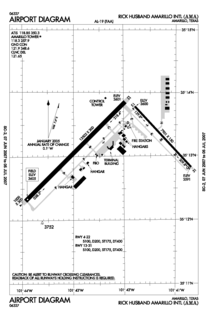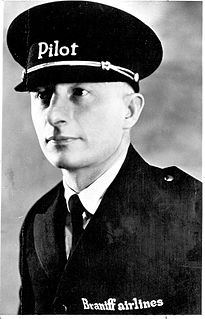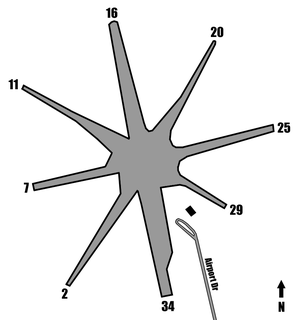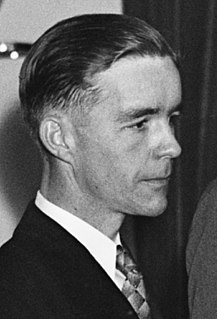
Chicago Midway International Airport, typically referred to as Midway Airport, Chicago Midway, or simply Midway, is a major commercial airport on the Southwest side of Chicago, Illinois, located approximately 12 miles (19 km) from the Loop business district. Established in 1927, Midway served as Chicago's primary airport until the opening of O'Hare International Airport in 1955. Today, Midway is one of the busiest airports in the nation and the second-busiest airport both in the Chicago metropolitan area and the state of Illinois, serving 20,844,860 passengers in 2019.

Rick Husband Amarillo International Airport is a public airport six miles (10 km) east of downtown Amarillo, in Potter County, Texas, United States. The airport was renamed in 2003 after NASA astronaut and Amarillo native Rick Husband, who died in the Space Shuttle Columbia disaster in February of that year.

Braniff Airways, Inc., operated as Braniff International Airways from 1948 until 1965, and then Braniff International from 1965 until air operations ceased, was an airline in the United States that once flew air carrier operations from 1928 until 1982 and continues today as a retailer, hotelier, travel service and branding and licensing company, administering the former airline's employee pass program and other airline administrative duties. Braniff's routes were primarily in the midwestern and southwestern United States, Mexico, Central America, and South America. In the late 1970s it expanded to Asia and Europe. The airline ceased air carrier operations in May 1982 because of high fuel prices, credit card interest rates and extreme competition from the large trunk carriers and the new airline startups created by the Airline Deregulation Act of December 1978. Two later airlines used the Braniff name: the Hyatt Hotels-backed Braniff, Inc. in 1983–89, and Braniff International Airlines, Inc. in 1991–92.
Charles B. Wheeler Downtown Airport is a city-owned, public-use airport serving Kansas City, Missouri. Located in Clay County, this facility is included in the National Plan of Integrated Airport Systems, which categorized it as a general aviation reliever airport.

Manhattan Regional Airport in Riley County, Kansas, United States, is the second-busiest commercial airport in Kansas. It is owned by the city of Manhattan, Kansas, and is about five miles southwest of downtown Manhattan. American Airlines serves the airport with five daily flights to Chicago O'Hare International Airport and Dallas/Fort Worth International Airport. The airport is also used for general aviation and for planes chartered by the military and college sports teams.

Paul Revere Braniff was an airline entrepreneur. Braniff was one of the original founders of Braniff International Airways. He served as a mechanic in World War I in the United States Army and then as a pilot in World War II.

Central Nebraska Regional Airport is three miles northeast of Grand Island, in Hall County, Nebraska. It is owned by the Hall County Airport Authority. The airport sees two airlines, Allegiant Air which flies independently and American Eagle which is subsidized by the federal Essential Air Service program. In 2016 the airport had 68,879 passenger boardings (enplanements), a 6.6% increase from the 64,602 enplanements in 2015. The airport had 7,961 enplanements in calendar year 2008, 20,136 in 2009 and 37,101 in 2010.

Avco Corporation is a subsidiary of Textron which operates Textron Systems Corporation and Lycoming.

West Mesa Airport, also known as Western Air Express Airport, TWA Airport, or Cutter-Carr Airport, was an airport on the West Side of Albuquerque, New Mexico, United States, which was the city's main commercial aviation facility during the 1930s. It was built in 1929 by Western Air Express as a stop on the airline's Los Angeles–Kansas City route, with a hangar and passenger terminal added in 1930. It was the city's second airfield after the original Albuquerque Airport, which was used by a rival airline, Transcontinental Air Transport (TAT). The two airlines merged in 1930 to form TWA, moving all of their operations to the West Mesa field. The merger gave TWA control of the nation's first coast-to-coast passenger airline route and allowed it to secure a lucrative federal airmail contract.

Topeka Regional Airport, formerly known as Forbes Field, is a joint civil-military public airport owned by the Metropolitan Topeka Airport Authority in Shawnee County, Kansas, seven miles south of downtown Topeka, the capital city of Kansas. The National Plan of Integrated Airport Systems for 2011–2015 called it a general aviation airport.

Braniff International Airways Flight 250 crashed near Falls City, Nebraska, on August 6, 1966, en route to Omaha from Kansas City, Missouri. Thirty-eight passengers and four crew members were killed in the crash, which occurred in a farm field late on a Saturday night. In-flight structural failure due to extreme turbulence in an avoidable weather hazard was cited as the cause.

Mid-Continent Airlines was an airline which operated in the central United States from the 1930s until 1952 when it was acquired by and merged with Braniff International Airways. Mid-Continent Airlines was originally founded as a flight school at Rickenbacker Airport in Sioux City, Iowa, during 1928, by Arthur Hanford Jr., a dairy operator. The Hanford Produce Company was the largest creamery in the United States with over 100 trucks in operation. The company was primarily a dairy but also sold ice cream and poultry. The Hanford's also founded and built the new Rickenbacker Airport and operated eight gas stations and several service repair garages under the name Hanford's, Inc. The airport was a division of Hanford's, Inc., but the service stations and garages were later sold to finance airline operations. Mid-Continent was based in Kansas City, Missouri at the time of its acquisition by Braniff.

The Fokker F-11 was a luxury flying boat produced as an 'air yacht' in the United States in the late 1920s. Technically the aircraft was the Fokker Aircraft Corporation of America's Model 9. It was sold in North America as the Fokker F-11 and was offered in Europe as the Fokker B.IV. By the time the first six aircraft had been constructed, it was already evident that the design was not going to sell well. A few were sold, two to notable multi-millionaires; Harold Vanderbilt and Garfield Wood each purchasing one. One was bought by Air Ferries in San Francisco. The F-11A cost $40,000 but the price was slashed to $32,500 as the depression set in during 1930. The F-11 was a commercial failure.

Fairfax Municipal Airport was a Kansas City, Kansas airfield from 1921 that was used during 1935–1949 by the military. Federal land adjacent to the airfield included a WWII B-25 Mitchell plant and modification center and a Military Air Transport terminal. After being used as a Cold War-era Air Force Base, it was used for airliner servicing by TWA and for automobile and jet fighter aircraft production by General Motors, which built a 1985 Fairfax Plant over runways when the municipal airport closed.
Stout Air Services was an airline based in the United States. Stout Air Services was the first regularly scheduled passenger airline in America.

Robertson Aircraft Corporation was a post-World War I American aviation service company based at the Lambert-St. Louis Flying Field near St. Louis, Missouri, that flew passengers and U.S. Air Mail, gave flying lessons, and performed exhibition flights. It also modified, re-manufactured, and resold surplus military aircraft including Standard J, Curtiss Jenny/Canuck, DeHavilland DH-4, Curtiss Oriole, Spad, Waco, and Travel Air types in addition to Curtiss OX-5 engines.
Universal Aviation Corporation was an airline holding company based in United States.
Parks College Airline was an defunct airline based in the United States.

Gordon Sprigg Darnell was an American auto mechanic, airplane mechanic, Army officer, Army pilot, airmail pilot, airline pilot, volunteer fireman and one of ten recipients of the Airmail Flyers' Medal of Honor.
This is the history of Braniff International Airways.















